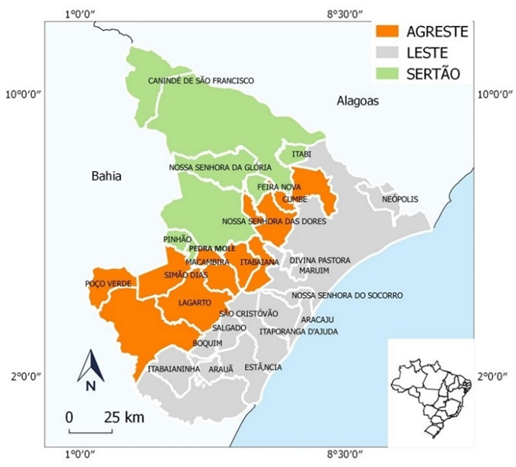Characterization of goat and sheep production in the state of Sergipe, Northeast of Brazil
DOI :
https://doi.org/10.21708/avb.2020.14.2.9247Résumé
Characterization of the profile of goat and sheep production in Sergipe enables better understanding of the main barriers linked to low productivity, generating important information for the development of this sector. The objective was to identify and characterize the production of goats and sheep in Sergipe. From 2011 to 2014, 41 goat properties and 60 sheep properties were analyzed, located in 25 municipalities in the three mesoregions of the State (Leste, Agreste, and Sertão). The information was obtained through application of a structured questionnaire to the farmers addressing topics such as: characterization of the property, herd, facilities, sanitary, nutritional, and reproductive management, and socioeconomic aspects of the farmer. The results demonstrated that 58.5% (24/41) of goat farms had an area less than 30 hectares (ha), reared predominantly mixed breed animals (SRD), with low use of technologies, aiming at family consumption, and complementing income through local marketing. On the sheep properties, 58.3% (35/60) were over 100 ha and used for the production of Santa Inês sheep and crossbreeds together with cattle. Significant flaws were also observed in feed, sanitary, and reproductive management, emphasizing the non-use of preserved foods and forages typical of the region, factors that contribute to the low level of productivity and sustainability of production in a viable and homogeneous manner. The findings led to the conclusion that more organized production is necessary, mainly through investment in technologies and qualified and continuous rural extension, aiming at improving the production, productivity, income, and quality of life of the breeders.
Téléchargements

Téléchargements
Publié-e
Numéro
Rubrique
Licence
Autores que publicam na Acta Veterinaria Brasilica concordam com os seguintes termos: a) Autores mantém os direitos autorais e concedem à revista o direito de primeira publicação, com o trabalho simultaneamente licenciado sob a Licença Creative Commons Attribution que permite o compartilhamento do trabalho com reconhecimento da autoria e publicação inicial nesta revista. b) Autores têm autorização para assumir contratos adicionais separadamente, para distribuição não-exclusiva da versão do trabalho publicada nesta revista (ex.: publicar em repositório institucional ou como capítulo de livro), com reconhecimento de autoria e publicação inicial nesta revista. c) Autores têm permissão e são estimulados a publicar e distribuir seu trabalho online (ex.: em repositórios institucionais ou na sua página pessoal) a qualquer ponto antes ou durante o processo editorial, já que isso pode gerar alterações produtivas, bem como aumentar o impacto e a citação do trabalho publicado (Veja O Efeito do Acesso Livre).


 Esta obra está licenciada com uma Licença
Esta obra está licenciada com uma Licença 